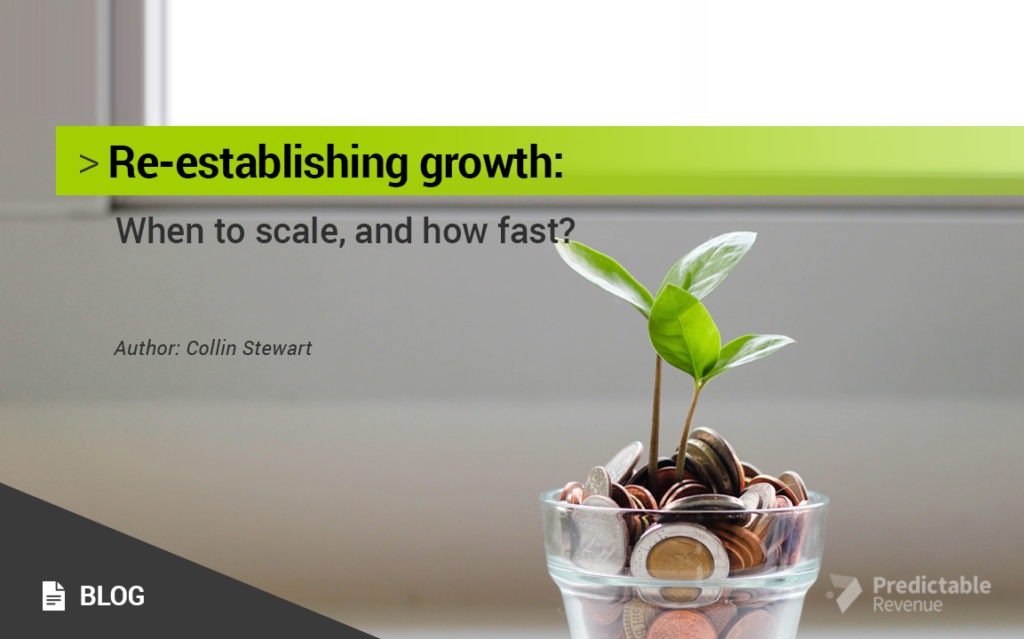Re-Establishing Growth: When to Scale, and How Fast?

When to scale? And how fast? Those are the two questions that keep entrepreneurs up at night!
The good news is there is a data-driven approach to these two critical questions: When to scale? and how fast? When done correctly, driving revenue growth at your company and what to expect at each stage, is quite measurable giving way to better decision making.
When Should We Begin Scaling Again?
Mark Roberge is Managing Director at Stage 2 Capital, the first venture capital firm run and backed by heads of sales and marketing. He is also a Senior Lecturer at the Harvard Business School where he teaches courses on sales, marketing, and entrepreneurship.
According to Mark Roberge, there are three vital stages to consider in order to drive revenue. The three stages are Product-Market Fit; Go-to-Market Fit and lastly Growth and Moat.
Creating a framework to systematically approach each stage of growth and what you should focus on to get to scale faster, forms the basis of his Step-by-Step Guide to Revenue Growth.
When entrepreneurs are asked “how’s your company going?” The initial response might be how fast you’re growing revenue. If you’re an investor, what’s the first question asked to a company you might be interested in backing? How fast are you growing revenue?
Revenue is a key factor, but according to Mark’s theory, we should also be talking about revenue retention. The key formula for getting 100% revenue retention, 200% revenue growth, is to address the underlying questions: How do you want to get there? What’s the best way?
Option A is 100% revenue retention, but mediocre growth at 30 or 50% revenue growth. Option B is having awesome revenue growth at 200%, but mediocre revenue retention at 70%. In his view, it’s much easier to pull the throttle once you’ve got great revenue retention than it is to actually fix a retention problem while a company is scaling. In other words, he believes it’s easier to slow down than to speed up.

So, Why Not Start There?
If you’re trying to re-establish product market fit and re-establish your positioning in the marketplace — knowing whether you’re ready to scale — starts with customer success. A data-driven approach necessarily tracks both sales and revenue over a period of time — and tells us when the company is moving in the right direction.
Listening to customer measurements is vital. Merely selling your product, doesn’t actually mean you have product market fit but rather monitoring customer retention would have greater meaning and more value than simply measuring sales. Mark recommends, if you had to pick one metric to set as a goal, it should be customer retention. Interestingly, of all the metrics one could look at to measure growth, customer retention is the better indicator.
Customer retention answers the critical decision on when to start hiring additional salespeople as well.
Measure Customer Success
Mark talks about dealing with the silent killer Churn. In his view, Churn is a lagging indicator and presents a serious problem. His solution is to get out in front of the issue. Leading SaaS companies like Slack and Hubspot have identified certain behaviors in the early phases that indicate long-term, high-value prospects. With Slack it was delivery of 2,000 team messages. For Hubspot, it’s when someone uses 5 of 20 features within the first 60 days.
It’s important to know what a customer may be doing during the first 30 to 60 days of using a product to signal that they are a good long-term prospect. Again, the importance of measuring customer success!
Scaling a business successfully requires more than just achieving product market fit and then hiring 20 sales reps. Filling up the hiring funnel without having checked all of the right boxes risks firing those reps a year later!
Mark’s approach to scaling is to establish a framework around product market fit that’s measured by customer value retention. Only once you’ve got that in place are you in a position to start thinking about scaling up.
His biggest piece of advice would be not to scale before you have a solid foundation to build on. In other words, pace yourself and build on robust recurring revenue and customer retention.
We were honored to have Mark Roberge at Predictable Revenue’s Own Your Growth Summit, discussing the scientific, data-driven approach: when to scale, and how fast? If you’d like to know more in detail, watch Mark’s session below.
Experience and a lot of testing have shown us that it is possible to create email templates that people actually resonate with.
You don’t have to figure it out alone, whether you’re starting off as a sales representative, looking to improve your game or providing your team with expert advice, we have your back!